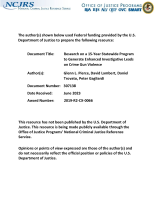State governments
Comparison of Privately and Publicly Operated Corrections Facilities in Kentucky and Massachusetts - Final Report
Issues in Contracting for the Private Operation of Prisons and Jails - Executive Summary
EASTSIDE SUBSTANCE ABUSE AWARENESS PROGRAM EVALUATION, 1993
The Daunting Task of Strengthening Medical Examiner and Coroner Investigations Across Hundreds of Jurisdictions
After a five-year fact-finding mission, a multi-agency working group has identified a host of problems in the U.S. medical examiner/coroner system, but solutions remain elusive.
Webinar Transcript: Fiscal Year 2024 Evaluating Strategies to Advance the Implementation of Evidence-Based Policies and Practices Solicitation
This webinar provided an overview of the NIJ FY 2024 Evaluating Strategies to Advance the Implementation of Evidence-Based Policies and Practices solicitation, in which...
Research on a 15-Year Statewide Program to Generate Enhanced Investigative Leads on Crime Gun Violence
Tribal Crime, Justice, and Safety, Part 2
Stacy Lee Reynolds and Christine (Tina) Crossland continue their discussion of tribal crime, justice, and safety, including how Native American persons experience crime victimization at higher rates than non-Native people and the jurisdictional complexities in responding to tribal crime, justice, and safety. Read the transcript.
Listen to the first half of Stacy and Tina’s discussion.
Reading and Resources from NIJ
Tribal-Researcher Capacity Building Grants
National Juvenile Court Data Archive: Final Technical Report
Tribal Crime, Justice, and Safety, Part 1
Research indicates that Native American persons experience crime victimization at higher rates than non-Native people. Furthermore, the unique position of American Indian and Alaska Native tribes as both sovereign nations and domestic dependents of the U.S. creates jurisdictional complexities in responding to crime, justice, and safety. Senior social and behavioral scientist Christine (Tina) Crossland discusses NIJ’s research on these topics, especially on the prevention of violence towards American Indians and Alaska Natives. Communications Assistant Stacy Lee Reynolds hosts.
Implementing NAGPRA Connecting Medical Examiner and Coroner Offices to Tribal Partners
This project is designed to connect tribal partners to ME/C offices to facilitate successful disposition protocols for non-forensically significant Native American remains that are compliant with the Native American Graves Protection and Repatriation Act of 1990 (NAGPRA).
See the YouTube Terms of Service and Google Privacy Policy
Dual System Youth: At the Intersection of Child Maltreatment and Delinquency
Across the country, child welfare and juvenile justice systems now recognize that youth involved in both systems (i.e., dual system youth) are a vulnerable population who often go unrecognized because of challenges in information-sharing and cross system collaboration. In light of these challenges, national incidence rates of dual system youth are not known.
See the YouTube Terms of Service and Google Privacy Policy
National Evaluation of the Correctional Options Demonstration Program
Thinking About Crime: A Federal Perspective on a Local Issue
CBRNE Up to Standards
Increasing the Effectiveness and Efficiency of Rural Police Departments
Obtaining Federal Benefits for Disabled Offenders: Part 2 -- Medical Benefits
Fiscal Year 2017 Report on the Paul Coverdell Forensic Science Improvement Grants Program
Violence Against American Indian and Alaska Native Women and Men - 2010 Findings from the National Intimate Partner and Sexual Violence Survey
This seminar provides the first set of estimates from a national large-scale survey of violence against women and men who identified themselves as American Indian or Alaska Native using detailed behaviorally specific questions on psychological aggression, coercive control and entrapment, physical violence, stalking, and sexual violence. These results are expected to raise awareness and understanding of violence experienced by American Indian and Alaska Native people.
See the YouTube Terms of Service and Google Privacy Policy
Changing the Behavior of Drug-Involved Offenders: Supervision That Works
A small number of those who commit crimes are heavily involved in drugs commit a large portion of the crime in this country. An evaluation of a "smart supervision" effort in Hawaii that uses swift and certain sanctioning showed that individuals committing crimes who are heavily involved in drug use can indeed change their behavior when the supervision is properly implemented.
See the YouTube Terms of Service and Google Privacy Policy
The National Broadband (Communications) Plan: Issues for Public Safety
The Federal Communications Commission delivered the National Broadband Plan in March 2010. As part of the plan, the FCC proposed a strategy for implementing a national public safety broadband network that would allow public safety responders anywhere in the nation to send and receive critical voice, video and data to save lives, reduce injuries, and prevent acts of crime and terror. How this strategy is implemented will have a significant impact on criminal justice and other public safety agencies nationwide, both with respect to operational capability and to resources.
Funding Opportunities for Publicly Funded Crime Labs, Fiscal Year 2017
This webinar will inform the audience of the changes to three programs available for publicly funded forensic laboratories and introduce a new program for FY 2017. Changes to existing programs will be highlighted and presenters will discuss the background and goals of the solicitations, recommendations for successful applications, application expectations and requirements, the review process, and the application checklist. There will also be time for questions and answers at the end of the webinar.
Solicitations discussed include:
See the YouTube Terms of Service and Google Privacy Policy
An Examination of Justice Reinvestment and Its Impact on Two States
Funded in part by the Bureau of Justice Assistance and the Pew Center on the States, the justice reinvestment project is a data-driven strategy aimed at policymakers to "reduce spending on corrections, increase public safety and improve conditions in the neighborhoods to which most people released from prison return." Representatives from two states where the justice reinvestment strategy is currently being implemented will discuss how it is being used to reduce the rate of incarceration and how states can reinvest in local communities.




